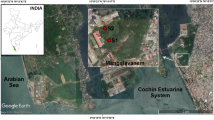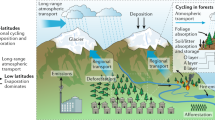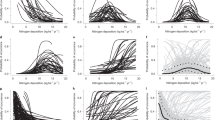Abstract
THE concentrations of toxic chemicals in the atmosphere and their deposition and long-range transport are becoming one of the more prominent issues in environmental chemistry. In 1986, a report1 was published documenting the levels of DDT (p,p′-dichlorodiphenyl-trichloroethane) and other organochlorine contaminants in the muscle tissue of pike and herring from areas in and around Sweden. There has previously been a downward trend in residue levels but in parts of Sweden and the south Baltic during 1983-84, the ratio of p,p′-DDT to its metabolites significantly increased, indicative of freshly released DDT from a source south of Sweden. (DDT has been restricted or banned in most of Europe since the 1970s.) It was established2 that an increased forest spraying program using DDT was implemented in 1984 in the southern part of East Germany. DDT can be transported over very long distances3 and in light of the above there is a need for an extensive field programme to monitor such pollution and locate its source. Here we test the hypothesis that the pine needle is a suitable monitoring matrix and delineate the extent of the DDT contamination of 1983–84. We conclude that the pine needle is a suitable monitor of atmospheric pollution and that because of the widespread distribution of the pine, it may provide time-series data for much of the Northern Hemisphere from which trends in atmospheric pollution may be discerned.
This is a preview of subscription content, access via your institution
Access options
Subscribe to this journal
Receive 51 print issues and online access
$199.00 per year
only $3.90 per issue
Buy this article
- Purchase on Springer Link
- Instant access to full article PDF
Prices may be subject to local taxes which are calculated during checkout
Similar content being viewed by others
References
Olsson, M. & Reutergardh, L. Ambio 15, 103–109 (1986).
Academy of Agricultural Science, Institute for Plant Protection Research 1987/88 Plant Protection: List of Substances (VEB Deutscher Landwirtschafts, Berlin, 1986).
Peakall, D. B. Atmos. Envir. 10, 899–900 (1976).
Kerler, F. & Schonherr, J. Archs envir. Contam. & Tox. 17, 1–6 (1988).
Lyman, W. J., Reehl, W. F. & Roseblatt, D. H. in Handbook of Chemical Property Estimation Methods: Environmental Behaviour of Organic Compounds. Ch. 1 (McGraw-Hill, New York, 1982).
Schuck, H. J. Flora 161, 604–622 (1972).
Gaggi, C., Bacci, E., Calamari, D. & Fanelli, R. Chemosphere 14, 1673–1686 (1985).
Thomas, W., Ruhling, A. & Simon, H. Envir. Pollut. A36, 295–310 (1984).
Jensen, S. Nordisk Biocid-Information 7, pap. la (Nordforsk's Biocidsekretariat, Stockholm, 1966).
Hadley, N. F. Biol. Rev. 56, 23–47 (1981).
Fries, G. F. J. envir. Qual. 11, 14–20 (1982).
Schonherr, J. Planta 131, 159–164 (1976).
Gothe, R. et al. Tetrahedron Lett. 49, 4501–4504 (1976).
Moilanen, K. W., Crosby, D. G., Soderquist, C. J. & Wong, A. S. Envir. Sci. Res. 6, 45–60 (1975).
Fuhremann, T. W. & Lichtenstein, E. P. J. agric. Fd Chem. 28, 446–452 (1980).
Quistad, G. B. & Mean, J. J. Residue Rev. 85, 173–197 (1983).
Hulten, E. & Fries, M. in Atlas of North European Vascular Plants. Vol. I, plate 80. (Koelz Scientific, Konigstein, 1986).
Author information
Authors and Affiliations
Rights and permissions
About this article
Cite this article
Eriksson, G., Jensen, S., Kylin, H. et al. The pine needle as a monitor of atmospheric pollution. Nature 341, 42–44 (1989). https://doi.org/10.1038/341042a0
Received:
Accepted:
Issue Date:
DOI: https://doi.org/10.1038/341042a0
This article is cited by
-
Leaf reflectance and functional traits as environmental indicators of urban dust deposition
BMC Plant Biology (2021)
-
Persistent organic pollutant cycling in forests
Nature Reviews Earth & Environment (2021)
-
Determination of polycyclic aromatic hydrocarbons in the soil, atmospheric deposition and biomonitor samples in the Meric-Ergene River Basin, Turkey
Environment, Development and Sustainability (2020)
-
The use of vegetation, bees, and snails as important tools for the biomonitoring of atmospheric pollution—a review
Environmental Science and Pollution Research (2019)
-
Modelling benzo[a]pyrene in air and vegetation for different land uses and assessment of increased health risk in the Iberian Peninsula
Environmental Science and Pollution Research (2017)
Comments
By submitting a comment you agree to abide by our Terms and Community Guidelines. If you find something abusive or that does not comply with our terms or guidelines please flag it as inappropriate.



